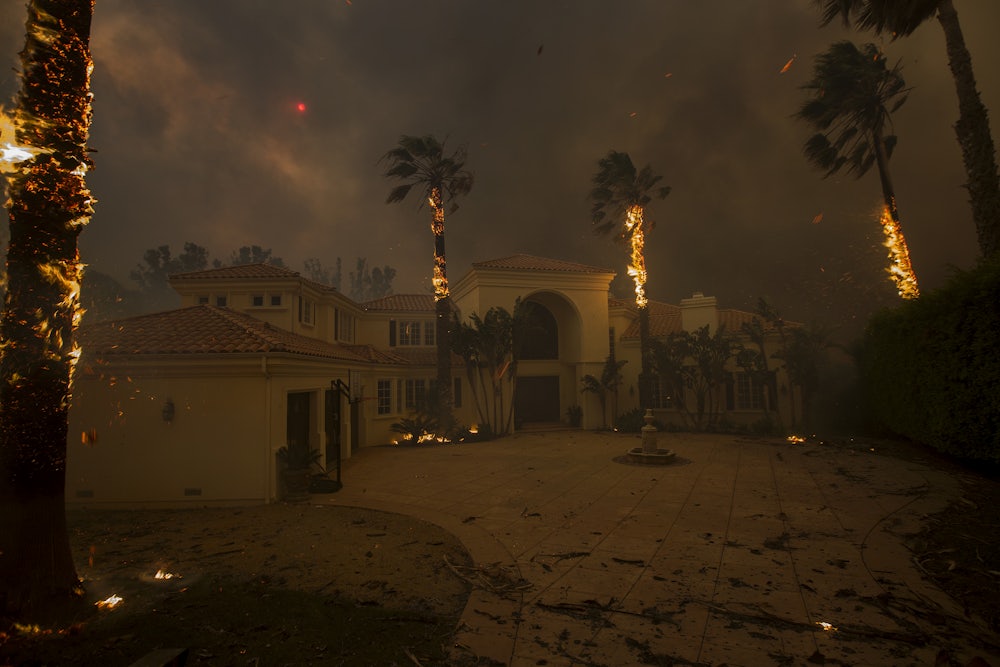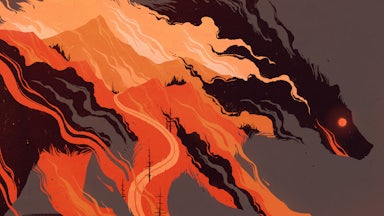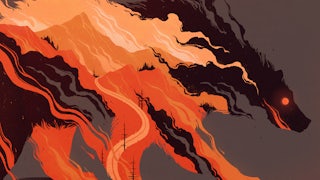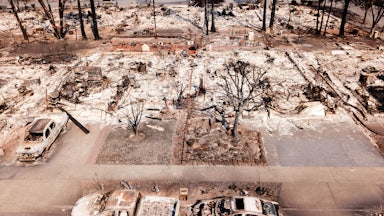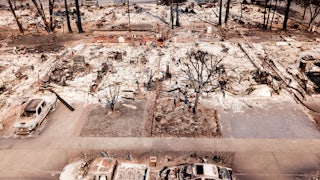In his 1995 essay The Case for Letting Malibu Burn, the radical historian Mike Davis references a story published several years earlier in The Malibu Times. The article details the pluck of two local housewives who escaped the ravenous 1993 Old Topanga Fire on kayaks, towing their little dogs along with them. Davis, as always, digs deeper. “Only the fine print revealed that, in saving their pets, they had left their Latina maids behind,” he writes.
Davis’s piece, which was included in his 1998 collection, Ecology of Fear, decries the maddening contradiction of a city lavishing millions in public money to defend privately owned, fire-prone land, while its failures to regulate tenement housing regularly condemned poor, Central American tenants to a fiery death. In the decades since the essay’s publication, the wildfires around Los Angeles have only worsened; so has wealth inequality. One can imagine Davis’s housewives, senior citizens now, lobbying the county to do something about the homeless encampments near their very combustible properties.
Their entreaties wouldn’t have fallen on deaf ears: The county has had the incendiary potential of homeless encampments in its sights for some time now. Last month, the Los Angeles Board of Supervisors voted to ban encampments in “very high fire hazard severity zones” of unincorporated L.A. county. “It’s just too dangerous to everybody,” said Supervisor Sheila Kuehl, who brought the motion.
Unincorporated areas account for 65 percent of L.A. County’s territory, including rural zones like the Angeles National Forest, the Santa Monica Mountains, and Topanga State Park; they are inhabited by just 10 percent of the county’s residents. Though the scales may be starting to tip as the wildfire insurance industry bottoms out, state and local policy has generally incentivized residents of high fire-risk areas to rebuild rather than move. The Los Angeles Fire Department likely spends hundreds of millions of dollars battling blazes in these zones each year, despite what Davis called “the essential dependence of the dominant vegetation of the Santa Monicas … upon this cycle of wildfire.” Now the L.A. County Sheriff’s Department, which has been tasked with informing and relocating unhoused residents in these areas, will be marshaled in service of the same cause: defending the property values of affluent residents from the inevitable yearly infernos that threaten their homes.
Deadly tenement conflagrations are largely a thing of the past in Los Angeles, but the encampment is a specter haunting homeowners across the county. The neglected apartment buildings Davis described in The Case for Letting Malibu Burn were at least enriching absentee landlords, some of whom likely resided in Los Angeles’s desiccated hills themselves; unhoused people provide no such opportunity for profit extraction. In his essay, Davis diagnosed the creation of wealthy rural enclaves across L.A. County as, quoting Reyner Banham, “thickets of privacy” against the hoi polloi. For a homeowner in Malibu or Topanga, an SRO fire in Westlake or downtown L.A. hardly poses a personal threat, but there are unhoused people living everywhere in the county these days, and a blaze begun under an overpass, the thinking goes, can spread quickly to the multimillion-dollar residences nearby.
In 2017, the Skirball fire, which local officials claim started in a hidden encampment near Sepulveda Boulevard, ended up destroying six homes in Bel Air, crystallizing homeowners’ suspicions about their unhoused neighbors. In the aftermath of that fire, the LAFD started tracking homelessness-related fire data, and Los Angeles Mayor Eric Garcetti created a taskforce, composed of police, fire department, and homelessness services officials, to find encampments in high fire-risk areas and try to get people to leave.
Fears about the menace lurking within homeless encampments have stirred up a vigilante fervor among some homeowners. This past May, as a wildfire allegedly set by an arsonist threatened the Pacific Palisades, one of L.A.’s wealthiest zip codes, a post (since deleted) went up on the Residents Association Facebook page: “We cannot take the risk of allowing more homeless in a neighborhood with such a fragile environmental landscape.” Soon, the Citizen app had seized upon the image of an unkempt young man whom it identified as the suspect, offering a $30,000 reward in exchange for tracking him down. The man was detained by the sheriff’s department, then quickly released—there was no evidence of his involvement.
A recent local radio piece by Caleigh Wells detailed the anxieties of Sabine Niederberghaus, who owns a lavish horse ranch in the Topanga mountains with her plastic surgeon husband. The reporter called Niederberghaus’s home “one of the riskiest properties in Topanga,” noting that the house that formerly occupied the lot burned down in 1993.
Niederberghaus was careful with her language apportioning blame: “I don’t say that the fires are caused by [the] homeless or encampments,” she told Wells. “I call it … irresponsible human behavior.” Nonetheless, Niederberghaus supported moving the unhoused from the canyon area where she lives and has lately hosted meetings with neighbors to discuss how to proceed. “We have to do something about this,” she told Wells. “We know where the fires are coming from.”
The day before the county’s encampment ban, a group of Topanga residents submitted a letter urging the board to “take action … to prevent camping fires and similar high-risk human behaviors, in order to protect our lives, homes, and community, including the homeless themselves.” Public comment submitted by concerned citizens in favor of the ban struck a less diplomatic tone. From Shelley Schneider: “We need to protect our homes!” From Matthew Ferraro: “Homeless encampments have been a problem for Topangan homeowners for years because of the fire danger they impose.” From Marina Benvenga: “Please get the homeless out of Pacific Palisades, Topanga Canyon, Malibu, Woodland Hills, Calabasas.” From Adam Shapiro: “I have seen this problem getting worse and worse with [M]alibu owners ending up suffering the consequences.” From Arlinda Henderson: “Want them gone.” From Diana Regan: “Remove the homeless from fire zones permanently. Make it a crime to go back.”
Kuehl, the county supervisor for the Topanga area, has taken pains to articulate that her board’s decision is not a criminalization of homelessness per se. “It doesn’t mean that they can’t still be homeless somewhere. It just means they can’t be homeless in these zones,” she said.
Any homelessness services worker in the county could tell Kuehl that it’s no easy thing to go elsewhere; there is almost no permanent housing for the unhoused in L.A., and nowhere near enough shelter beds. Kuehl’s justifications also ignore how the board’s dictate interacts with 41.18, a recent city council ordinance that functionally criminalized homelessness by vastly restricting people’s ability to sleep and store personal belongings in public.
Where to, then? Should unhoused residents of Topanga become domestic climate refugees in Venice, where the air is clear and tinged by salt and a cool breeze rolls in from the sea, they will likely confront rogue park rangers or sheriff’s deputies out of jurisdiction, who will round them up and drive them elsewhere again. Should they congregate on Skid Row, the epicenter of the homelessness crisis in L.A., they will likely face greater danger than before. The reality is that fires do start in homeless encampments, and they have increased in frequency as the number of unhoused residents of L.A. goes up. But high-profile incidents like the Skirball Fire notwithstanding, the vast majority of encampment-related blazes occur in downtown L.A. and its environs, according to fire department data.
In 2020, the LAFD Battalion responsible for much of Topanga State Park fought 95 fires “linked to homelessness.” The battalion that covers downtown saw 1,556—over 16 times as many. In other words, homeless encampment fire patterns map pretty closely onto the tenement fires Davis examined in The Case for Letting Malibu Burn. When Los Angeles declares it illegal to camp outside in high–fire risk, low-density zones, the county essentially condemns unhoused people to the very same districts where they will experience the highest risk from encampment fires in the first place.
But those fires don’t present a hazard to wealthy hills-dwellers. They’d rather live with the danger they chose: making their home in remote canyons surrounded by bone-dry tinder in an era of worsening climate change, drought, and fires. Public money will keep flowing, subsidizing their ability to do so. And Topanga will burn, whether we let it or not.
